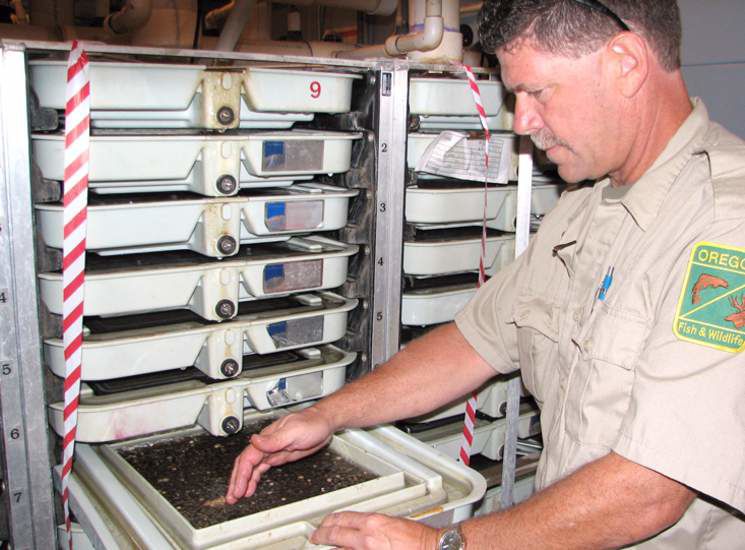Rogue summer salmon action on the Rogue
Published 5:00 am Thursday, July 9, 2009

- A guide and his clients work a run near Shady Cove for Rogue River spring Chinook.
We slid into a fishy-looking run, but there was a boat ahead of us. The guide tipped his hat. “If we get a couple more, we’ll have two.”
It’s hard to catch a salmon on a hot day with the sun on the water. But we had Keith Carter at the sticks and Dave Pease along for good luck.
In 1986, Dave Pease walked into the Cole M. Rivers Fish Hatchery and thought it looked like a fun place to work. Twenty-three years later, he is the assistant manager and the first friendly face many salmon see after three, four or five years in the ocean.
We were there to help him greet a batch of fresh fin-clipped kings, earlier in the day. These fish had survived years in the salt, sea lions and gauntlets of gillnetters, sport-fishermen and other hazards to end their race in the hatchery raceway.
We checked them for hardware: tags inserted in their beaks as smolts that provide information to help biologists understand these big fish. We found no tags, but the exercise opened my eyes to the inner workings of a hatchery.
Cole Rivers Hatchery in the tailwater of Lost Creek Reservoir on the Rogue River raises rainbow trout, steelhead, fall salmon and spring Chinook. We saw them all in various stages of their life cycles: football fields of fingerlings waiting for a feed; aisles of alevins, recently hatched.
Pease pulled out a tray of what had formerly been eggs. Thousands of inch-long baby salmon dashed headlong amid the remains of two dozen unhatched pink globes swirling in the water.
What I really wanted to see was the place where they clip the adipose fins from baby salmon. Wish granted. We stepped into a building, plumbed like the NASA space center with computers and monitors. Smolts were launched like rockets through long tubes, sized by laser, photographed, inspected, detected and funneled into tubes where they lose their fatty fins to the state.
The fish that were too small to be computer clipped were routed through another tube to a couple of ladies with long-limbed snippers. Reach down, grab, snip. Grab another, snip — making it easy for anglers, if they hook one, four or five years later, to tell the difference between a wild fish and a hatchery-reared Chinook.
I hoped I’d get a chance to examine an adipose fin later in the day.
It was 99 degrees at the boat ramp. Our guide, Keith Carter (www.cartersguideservice.com), pulled in at noon and we waited while dozens of rafters got ready for splash-and-giggle rides down the river. You want to see wildlife? Book a midday summer run.
Keith Carter handed out rods and a tray of cured steelhead eggs. I slid an orange puff ball onto the hook and cinched down a chunk of steelhead roe on a Daiichi hook. “Put on a two-ounce lead for this first run,” Carter said.
He pointed the bow of the boat downriver and we slid out into the main current. Wes Neal followed us down with Brad Douglas and John McDevitt in his boat. The first hole was a hard right turn with a soft spot on the outside.
Thumb the spool, let the current peel out the line, wait for the bump as the lead touches bottom. Thumb down. Lift. Bounce it back. Lift. Release. There is a rhythm.
We slid around the corner in time to see a bank fisherman hook up with an acrobatic 10-pound hen. Dropping in below them, we walked our baits downriver and I felt the downward motion turn to a wiggle. I set the hook twice, but it turned out to be a branch, not a salmon. We drifted down.
In a long deep run, a fish grabbed and charged upstream toward the boat. I couldn’t catch up. It spit the eggs, I set the hook against a pile of slack line, leaning so far back, my hat fell off.
Around a couple of corners, at a place called Dead Man Hole, with 150 feet of line out, a tug tingled in the rod tip and shivered in the grip. Thumb against the spool, I felt a head shake and slammed the rod back once and again. The fish turned its side to me and surged.
Ring finger against the pistol grip, thumb hooked over the top of the reel, I fought to gain line as Keith slipped us down to the top of the rapids. In the shallows above the tail-out, it turned and pointed back upstream. When I had the fish’s head up, I pulled the rod back up over my hat and Keith slid the net under 15 pounds of salmon.
This one had an adipose. A wild fish. We put it back in the water to make more salmon. “Hey Dave, we should have brought one of those gals from the hatchery … with her snippers,” Brad said.






